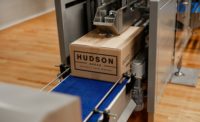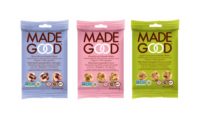 Sanitation, labor costs, line flexibility, and operating efficiency are all familiar challenges when it comes to food packaging processes. However, addressing these challenges does not have to be a challenge itself.
Sanitation, labor costs, line flexibility, and operating efficiency are all familiar challenges when it comes to food packaging processes. However, addressing these challenges does not have to be a challenge itself.
With the power of digital transformation, food packaging companies can deliver safer working environments and products and minimize costs and time associated with maintaining compliance. Harnessing the capabilities of the internet of things (IoT), digitally transforming facilities can improve operations and productivity while reducing costs and driving profitability. Through enhanced agility and control, connected, intelligent solutions empower swift adaptation to changing business conditions with real-time analytics.
Harpak-ULMA, a packaging equipment manufacturer, realized that making its packaging platforms smarter and more connected would drastically improve OT and IT staff operations. The company created a multi-phase, multi-year plan to digitally transform its portfolio and meet heightened customer expectations by delivering individual technologies and end-to-end packaging line automation, such as inspection, robotics, instrumentation, loading and conveyance, and palletizing equipment.
Powering efficient operations
The comprehensive plan aims to improve operational efficiency and Harpak-ULMA’s capabilities, including flow wrapping, vertical bagging, tray forming, case packing, thermoforming, palletizing automation equipment, and sleeving. In addition, the company wanted to enhance employee productivity and address the skills gap resulting from an aging workforce.
Utilizing solutions from Rockwell Automation, a global pioneer in digital transformation and industrial automation, the plan officially began implementation in October 2018. Additional partnerships with robotics enterprises and ancillary automation will help Harpak-ULMA’s customers access more capabilities for information integration.
Data-driven insights promote a connected ecosystem
The three-phase plan began with standardizing Rockwell Automation’s platform, which provides a single source for each application, including advanced production applications, controls, and components. Harnessing pre-integrated compatibility with PTC IoT software, Vuforia and Thingwox, Harpak-ULMA is driving workspace productivity and production efficiency. Currently, Harpak-ULMA is transitioning from the second phase to the third phase of the digital transformation initiative.
The second phase involved implementing augmented reality (AR) to address workflows and employee productivity and provide remote service and support. Enlisting Vuforia Expert Capture, an AR-based training tool, users can record videos with location-based directions, voice commands, gestures, and more. They can then revise and publish videos for easy access and comprehension for new team members. As a result, the solution improves the accuracy of unfamiliar tasks, reduce costs, and minimize the time necessary for training and comprehension.
During the third phase, the company will improve operational transparency and outcomes based on IoT data acquisition. Data-driven insights are a valuable tool throughout each stage of customer engagement, such as marketing and post-sale support. Harpak-ULMA will utilize this data for service development and production processes.
To help its customers reduce risk, especially for new initiatives, Harpak-ULMA will deliver platforms encompassing operational expertise, CAD digital twins, and rapid prototyping. The company will provide a service specializing in packaging and automation process assessments to streamline decision-making, enhancing productivity. Additionally, Harpak-ULMA will enhance production agility and minimize the lowest customer total cost of ownership (TCO).
Delivering long-term innovation with IoT
The final phase of Harpak-ULMA’s plan enables predictive maintenance analytics. Building a more connected enterprise that leverages real-time production insights directly impacts a company’s operational efficiency, safety, profitability, and competitive advantage.
To date, dozens of customers have adopted Harpak-ULMA’s smart connected platforms. The integration enables customers to use data insights to drive efficient responses to market changes while overcoming challenges related to the skills gap and aging workforce. In addition, these customers are better positioned to achieve productivity targets, control maintenance costs and enhance workplace safety, all from a single source that provides controls, advanced production applications, and components.
Through Harpak-ULMA’s mission to build more connected and intelligent enterprise processes, the company is dedicated to optimizing performance and achieving double-digit revenue growth. Following the completion of phases one and two, Harpak-ULMA has increased its profitability by 15 percent. During the final stage of the plan, Harpak-ULMA will establish a new line of business that specializes in utilizing various tools for artificial intelligence and machine learning on cloud-based data. The company will leverage industry benchmarking coupled with predictive analytics to deliver advanced customer outcomes and continuously foster innovation.
About Harpak-ULMA:
Harpak-ULMA Packaging offers a very broad range of packaging technologies to suit many needs—from simple, single components to highly complex, automated, fully integrated packaging lines.






